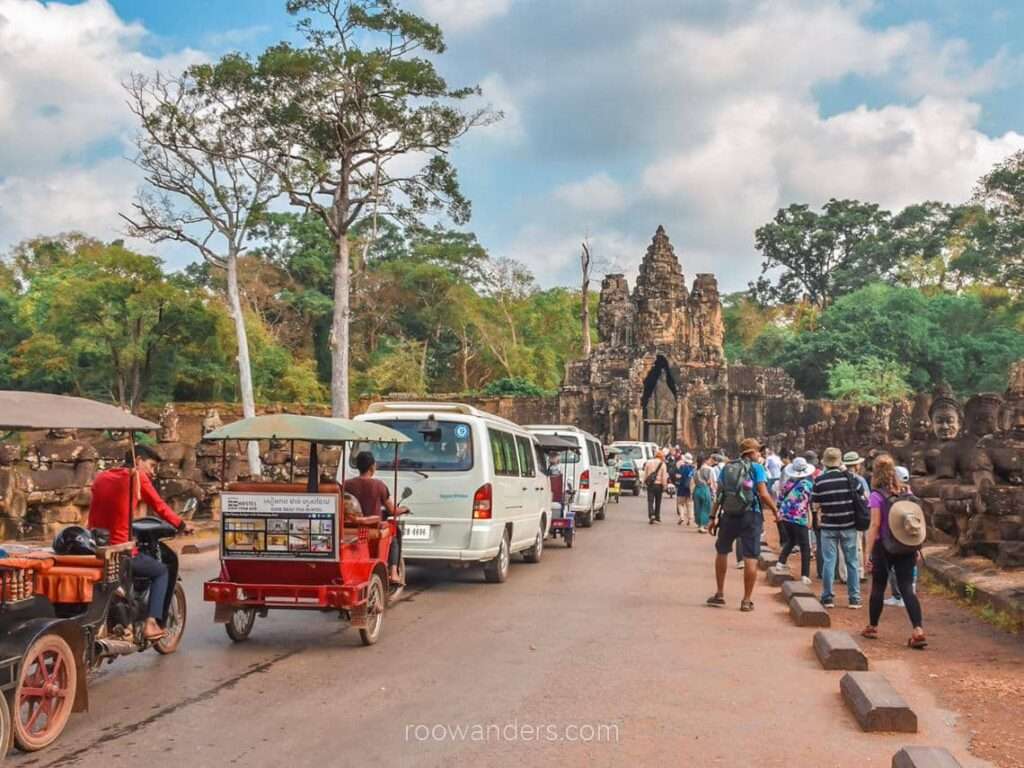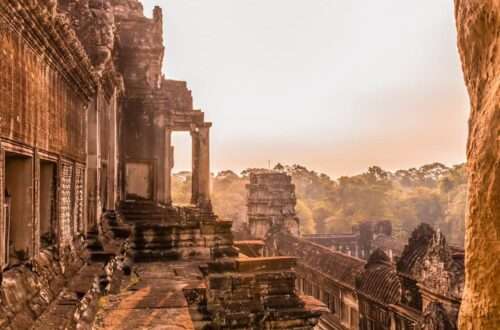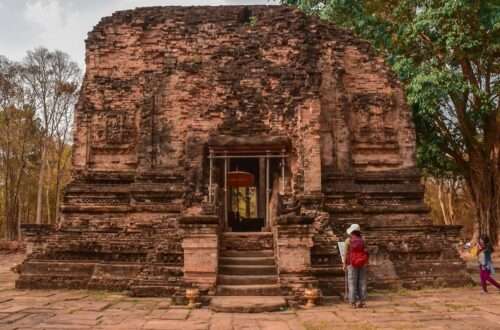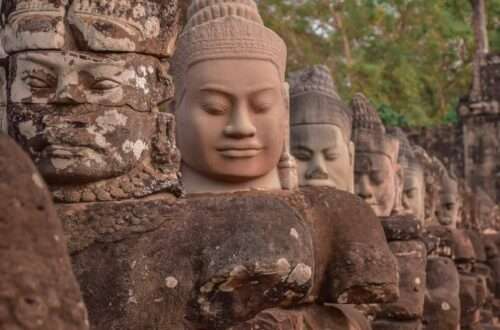
The Angkor Complex: Everything You Need to Know
Siem Reap and its Angkor Complex are most likely ranked high on the backpackers’ list in South East Asia.
It is where the impressive ancient miracle of Angkor Wat is and where you can sample a little of Cambodian culture and learn more about its history.
But how should one approach this large complex with hundreds of monuments and temples of varying significance scattered miles apart?
Here is my take on visiting the massive Angkor Complex.
Note: I am not a history junkie, and classify myself as a budget but not a miserly backpacker who wants to visit all the UNESCO sites in Cambodia.

This post may be updated periodically.
Angkor Complex
The place that is now Siem Reap was once the capital of the Khmer Empire.
The capital had been moved several times by different kings, but it was during the reign of the last successful king – King Jayavarman VII – that contributed to most of what we can see today. He completed the Angkor Wat and built numerous edifices in his capital, Angkor Thom.

How to Visit
The Angkor complex consists of a thousand temples of different sizes built for various functions.
Depending on your budget, schedule and interests, you could choose to do the small or big circuits. Tickets are sold based on the number of days you enter the complex.
As of November 2018, the ticket prices are as follows:
- One day: USD 37 (suitable for small circuit)
- Three days: USD 62 valid for 10 days from the issue date (suitable for the large circuit)
- Seven days: USD 72 good for 1 month from the issue date (beyond the large circuit)

2022 edit: Prices remained the same!
Grab any rickshaw drivers around the streets of Siem Reap, and you would find the map of both circuits plastered in their vehicles.
Circuits
Small Circuit
The small circuit covers fewer temples but temples of the most significance to the Angkor era. According to my guide, the structures in the small circuit are the architectural representatives of other smaller and less fancy edifices and temples beyond.
Edifices covered in the small circuit:
(1) Angkor Wat
(2) Phnom Bakheng
(3) South Gate (Tonle Om Gate)
(4) Angkor Thom
- Bayon Temple
- Baphuon Temple
- Phimeanakas
- Terrace of the Elephants
- Terrace of the Leper King
- Victory Gate
(5) Ta Keo
(6) Ta Prohm
(7) Banteay Kdei
(8) Srah Srang
Covering all those temples within one day under the hot and punishing sun and humidity was actually quite tiring. We started our day early to catch the sunrise at Angkor Wat and almost called it quits by noon – the hottest time – with a couple more temples to complete.

Big Circuit
The big circuit includes the periphery of the complex outside of the small circuit:
(1) Almost everything in the small circuit (except the middle part)
(2) North Gate of Angkor Thom
(3) Preah Khan
(4) Neak Pean
(5) Ta Som
(6) East Mebon
(7) Pre Rup
The three-day entry ticket works best when you include both the small and big circuits.

Choosing the Circuit
Having problems choosing your circuit?
Ask yourself these questions:
Are you-
- An Angkor fanatic and want to document all the edifices in the Angkor Complex → go for the seven-day ticket
- Keen to visit all the critical temples but do not want to suffer from temple burnout (wants to take it slow) → go for the three-day ticket
- Like me who just wants to see the best and move on → the one-day ticket

Guides
Visiting the complex without a guide is a waste of time unless you have done your homework and know what you are looking at.
Professional registered guides in khaki uniforms and red bandanas with ID cards are knowledgeable and proficient and can maximise your temple visits.
Some are multilingual and can speak fluently. They command the highest price.
Do not patronise unregistered guides.
Guidebooks help, but having someone local and trained to narrate the stories adds more dimensions to the experience. Besides, you will be supporting their livelihood.
We went with a mid-tier guide for USD 35. Tuk-tuk for that day was USD 18. These were pre-pandemic prices of March 2018.

Purchasing your tickets
Purchase your tickets to the Angkor complex from the official ticket centre – the Angkor Archaeological Complex – 4 km away from Siem Reap.
2022 edit: You may buy the Angkor Pass online now. I am unsure if there are additional online charges or if you have to exchange them for the physical pass at the office.
The ticket office opens from 4.30 am to 5.30 pm, not at 5 am as the board states. We were part of the long queues despite arriving a quarter after four.
One trick to save the hassle of queuing was to purchase the ticket after 5 pm for your visit the next day. Our guide tipped us on the news but miscalculated his travelling time.


Visiting Hours
Most temples are open to visitors from 7.30 am – 5.30 pm except the special few for sunrise/ sunset;
- 5 am – 5.30 pm: Angkor Wat and Srah Srang
- 5 am – 7 pm: Phnom Bakheng and Pre Rup

Best Time to Visit
Anytime is a good time to visit the complex, but the best time is between November and March when the weather is cool and dry. You will get crowds.
Anytime beyond Nov and Mar would see hotter and potentially wetter and muddier weather. But you would get fewer crowds and people photobombing you.
2022 edit: NOW is probably the bestest of best time since the pandemic to visit when China is still in lockdown and Cambodia is open for vaccinated travellers. Singaporeans and other ASEAN nationals are exempted from tourist visas. Yay!

Pointers You Should Not Miss
- Read about the temples! This, this and this help. Or you could read my brief post on the history of Angkor.
- Buy tickets after 5 pm. Saves you from travelling extra early in the morning to queue for the tickets.
- Bring lots of water and snacks. Food and drinks sold inside the complex are expensive.
- Sun shades, sun hats, sunblock. Or you would be sun-cooked.
- Umbrellas. Double function as a sun shade and a rain cover.
- Extra early morning rise. Catch the best spot for sunrise over Angkor Wat.
- Start early. Beat the mid-morning large tourist groups that come in bus loads.
- Admission tickets are non-refundable, non-transferable and non-negotiable. Plan properly and buy decisively.
- Phnom Kulen, Beng Mealea and Koh Ker are excluded from the pass. Their entrance fees were USD 20, USD 5 and USD 10, respectively.








2 Comments
Sak
Hey, you can buy Angkor Wat Ticket online and have it on your phone. Just show it to guard when needed. It works fine.
Roo
Hey Sak, thanks for reading and updating! I’d update this post soon with your feedback. 👍